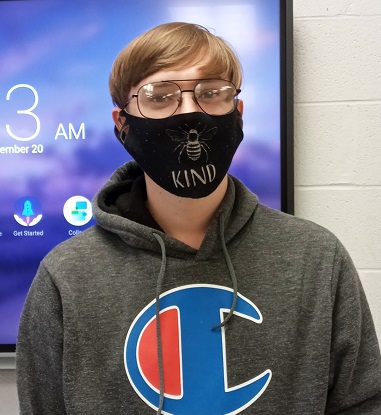Go-Fish gets complicated

Isaac Owens, student and creator of the game, standing in the gifted room where the game was born.
December 8, 2021
Everyone has played a card game here and there with friends or family, whether it be as simple as Uno or playing with an actual deck of cards. There are a limitless number of possibilities with what an individual can do with a deck of cards and some imagination. One student in particular, Isaac Owens, chose to take advantage of this and create his own card game.
It was a spark that was set off by a competition, the Husky Dog Pound competition, in which students from schools get to take a chance at creating a “Shark Tank” esc game to be judged. The contest will be held on March 28th of next year. However, his ambitions for this game are quite impressive as he plans to eventually have it evaluated and even published as an actual product. So, what is this product that is teeming with creativity?
As stated by the creator, Isaac Owens, it is built upon the card game Go Fish. The core mechanics of the game are very similar to that of Go Fish as each player gets to try and guess another player’s card with the end-goal being that you have played or discarded all cards in your hand. Where the creativity gets involved is everything that sets it apart from Go Fish. Isaac goes in-depth into what the game is meant to be, an asymmetric card game. What is an asymmetric card game? As described by him, an asymmetric card game differs from a usual card game. In a regular card game, all players start out with the same number of cards and are all capable of doing equally well. In a asymmetric card game, however, each player starts off with advantages and disadvantages compared to the other players. So how does this work?
The game can be played by 2 up to 8 players. There are 8 different “roles” players can choose, hence the 8-player limit. Each role has unique traits that sets it apart from every other role, so every player will be playing the game differently. The goal of the game isn’t necessarily the same Go Fish style that people are used to. Yes, players have to discard all the cards for the game to end, but how players win is quite different. Isaac developed a point system for the game, with all roles sharing a base point-gaining system mixed with the roles’ own unique mechanics. Some roles may want to keep cards to make use of their abilities while others may want other players to keep their cards. The game may be based upon a child’s card game, but it deviates from it immensely with strategy and thinking playing a large role in how you win.
He has been developing this game for several months now. He has had people play it and test them and has taken their feedback into consideration when trying to make it a more playable experience. Not only is this game a physical representation of a spark of creativity, but it shows the flexibility of the human mind. Isaac took a simple children’s card game, made it something more, and is now on track to publish this game as an official card game.

